 |
|
 |
Video Endoscopic Sequence 1 of 5.
Pill Esophagitis
This 65 year-old male, undergone an upper endoscopy due to epigastric pain, denies having fevers, nausea, vomiting, odynophagia and dysphagia was treated with alendronate (Fosamax®) and aspirin over the past months.
For further endoscopic information, download the video clip by clicking on the endoscopic image. Wait to be downloaded complete then Press Alt and Enter for full screen ( Windows Media), Real Player: Ctrl and 3.
All endoscopic images shown in this Atlas contain video clips. We recommend seeing the video clips in full screen mode.
|
|
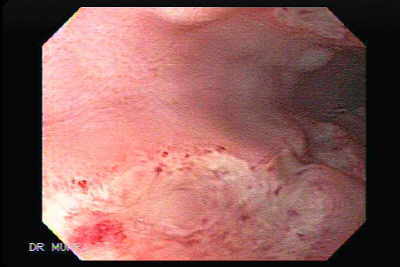 |
Video Endoscopic Sequence 2 of 5.
Endoscopy of Pill Esophagitis
Esophageal lesions can result from ingested medication which undergoes slow transient through esophagus with resulting prolonged mucosal contact and caustic damage. Typical agents include potassium chloride, quinidine, ascorbic acid, tetracyclines, NSAIDS, and bisphophonates
It is important that these medications be accompanied with ample water to prevent slow esophageal transit.
One study of aspirin sized barium tablets administered to patients undergoing routine upper GI showed that half remained in the esophagus for more than 5 minutes.
Bisphosphonates are particularly notorious for causing esophageal irritations.
|
|
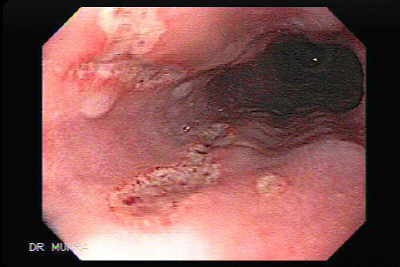 |
Video Endoscopic Sequence 3 of 5.
Endoscopy of Pill Esophagitis
Tetracyclines are the most common antibiotics to induce esophagitis, particularly doxycycline.
Essentially all of the antiinflammatory agents can damage the esophagus; the highest number of reported cases have been with aspirin.
The major offenders in the "other" category include
potassium chloride, quinidine preparations, and iron
compounds in the United States; emepronium, alprenolol,
and pinaverium are common etiologies in other countries.
In addition, the bisphosphonate alendronate has the
potential to be a cause because of its increasing use for the
treatment of osteoporosis and other disorders.
|
|
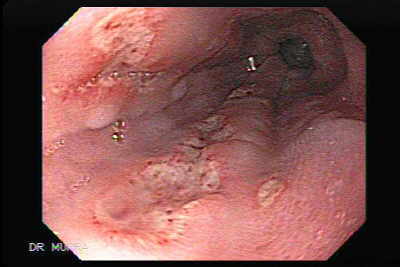 |
Video Endoscopic Sequence 4 of 5.
Endoscopy of Pill Esophagitis
PATHOGENESIS — The mechanism of injury is believed to be due to prolonged contact of the caustic contents of the medication with the esophageal mucosa.
Esophageal retention — Some degree of esophageal retention of pills or capsules occurs in normal individuals. However, the following situations enhance pill retention, thereby increasing the likelihood of esophageal injury.
Both lack of an adequate liquid bolus and a long period in the recumbent position are believed to play a major role in pill retention.
Ingestion of a pill immediately prior to sleep favors prolonged retention since salivation and swallowing frequency are markedly reduced during sleep.
|
|
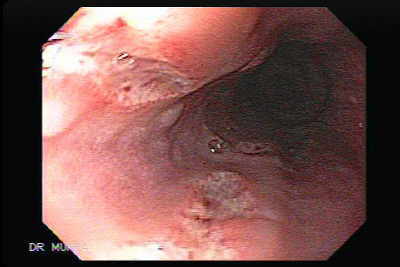 |
Video Endoscopic Sequence 5 of 5.
Endoscopy of Pill Esophagitis
Pills. Esophagitis can result when a swallowed pill gets stuck in the throat and burns the lining, usually when not enough liquid was used to wash down the pill. It may also occur if the esophagus does not contract properly or is narrowed because of a scar.
|
|
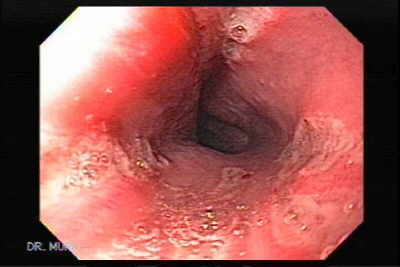 |
Video Endoscopic Sequence 1 of 2.
Pill Esophagitis.
This 43 year-old male, presented with dysphagia, endoscopy shows several ulcers in the upper third of the esophagus:
He was taken different pills.
|
|
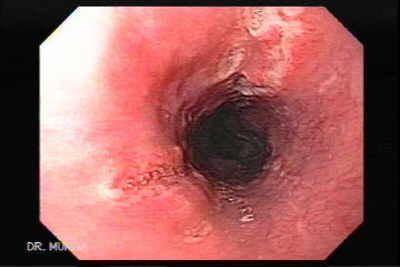 |
Video Endoscopic Sequence 2 of 2.
Endoscopy of Pill Esophagitis
More image and video clip.
|
|
|
|
|
|
|
